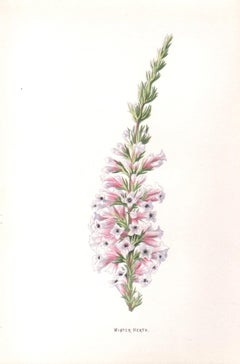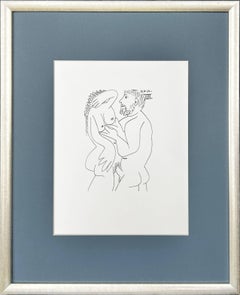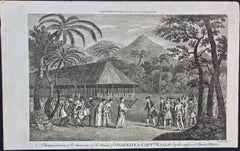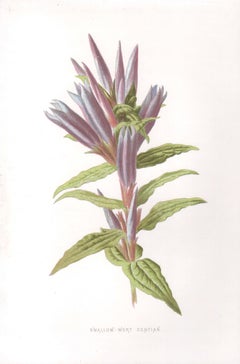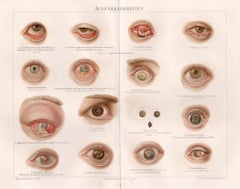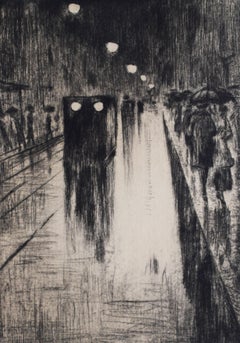Miniature More Prints
to
464
2,339
1,730
2,295
979
780
Overall Width
to
Overall Height
to
384
363
241
166
84
29
24
23
23
18
15
11
6
125
81
46
38
35
103
375
1,440
421
17
8
28
57
60
144
272
284
154
83
81
1,590
584
153
59
39
25
23
15
12
11
11
7
7
6
5
4
4
4
4
3
3
3
3
983
446
430
184
176
171
583
1,132
721
Size: Miniature
Winter Heath, English antique pink flower botanical chromolithograph, 1895
By Frederick William Hulme
Located in Melbourne, Victoria
'Winter Heath'
Process print from Frederick William Hulme’s ‘Familiar Wild Flowers’, circa 1890.
Hulme was known as a teacher and an amateur ...
Category
Late 19th Century Naturalistic Still-life Prints
Materials
Lithograph
The Taste of Happiness, Planche LXI
Located in OPOLE, PL
Pablo Picasso (1881-1973) - The Taste of Happiness, Planche LXI
Lithograph from 1970.
An unsigned and unnumbered edition of 666.
Dimensions of sheet: 32.5 x 25 cm
Dimensions in f...
Category
1970s Modern More Prints
Materials
Lithograph
Surrender of Tahiti to Captain Wallis: An Original 18th C. Engraving
By John Webber
Located in Alamo, CA
"A Representation of the Surrender of the Island of Otaheite to Capt.n Wallis, by the Supposed Queen of Oberea" is an original 18th century engraving created by Sparrow, from a drawi...
Category
1780s Landscape Prints
Materials
Engraving
$200 Sale Price
20% Off
Swallow-wort Gentian, English antique flower botanical chromolithograph, 1895
By Frederick William Hulme
Located in Melbourne, Victoria
'Swallow-wort Gentian'
Process print from Frederick William Hulme’s ‘Familiar Wild Flowers’, circa 1890.
Hulme was known as a teacher and an amateur botanist. He was the Professor ...
Category
Late 19th Century Naturalistic Still-life Prints
Materials
Lithograph
Eye Diseases, German antique medical chromolithograph print
Located in Melbourne, Victoria
'Augenkrankheiten'
(Eye Diseases)
German chromolithograph, circa 1895. Central vertical fold as issued.
240mm by 305mm (sheet)
Category
Late 19th Century Naturalistic More Prints
Materials
Lithograph
Leipzigerstraße in the Rain - German Impressionism Berlin
By Lesser Ury
Located in London, GB
This original etching is hand signed in pencil by the artist "L. Ury" at the lower left margin.
It is a signed proof from outside the edition of 30, printed and published by Fritz Gu...
Category
1920s Impressionist More Prints
Materials
Etching
Connecticut and Rhode Island. USA. Century Atlas state antique vintage map
Located in Melbourne, Victoria
'The Century Atlas. Connecticut and Rhode Island.'
Original antique map, 1903.
Central fold as issued. Map name and number printed on the reverse corners.
Sheet 29.5cm by 40cm.
Category
Early 20th Century Victorian More Prints
Materials
Lithograph
Champignons, French antique mushroom fungi chromolithograph, 1910
Located in Melbourne, Victoria
'162. Hypholoma sublateritium 163. Hypholoma fasciculare 164. Lacrymaria lacrymabunda'
Antique French mushroom / fungi chromolithograph.
From "Atlas des champignons de France, Suis...
Category
Early 20th Century Naturalistic Still-life Prints
Materials
Lithograph
Odontoglossums, English antique flower orchid botanical chromolithograph, 1896
Located in Melbourne, Victoria
'Odontoglossums'
Flowers are numbered with a key to the varieties below the image.
Antique English flower botanical chromolithograph.
Category
Late 19th Century Naturalistic Still-life Prints
Materials
Lithograph
Life (Ass-Backward and Upside Down)
By Adam Mars
Located in Miami, FL
Adam Mars(b. 1981, American)
Life (Ass-Backwards and Upside Down)
2020
Screenprint
11 x 14 in.
Edition of 20
Pencil signed and numbered
Adam Mars (born 1981...
Category
21st Century and Contemporary Contemporary Prints and Multiples
Materials
Screen
Jean Cocteau - Torrero - Original Lithograph
By Jean Cocteau
Located in Collonge Bellerive, Geneve, CH
Original Lithograph by Jean Cocteau
Title: Taureaux
Signed in the plate
Dimensions: 40 x 30 cm
Edition: 200
Luxury print edition from the portfolio of Trinckvel
1965
From the last po...
Category
1960s Modern More Prints
Materials
Lithograph
Birds of Paradise, German antique natural history chromolithograph print
Located in Melbourne, Victoria
'Paradiesvogel'
(Birds of Paradise)
German chromolithograph, circa 1895.
240mm by 155mm (sheet)
Category
Late 19th Century Naturalistic Animal Prints
Materials
Lithograph
Abstract Composition - Lithograph by André Masson - 1970s
By André Masson
Located in Roma, IT
Abstract Composition is an original colored lithograph realized in the half of XX century.
The artwork is hand signed on the lower right margin.
Numbered on the lower left. Edition...
Category
1970s Surrealist More Prints
Materials
Lithograph
Femme Nu
Located in OPOLE, PL
Henri Matisse (1869-1954) - Femme Nu
Photogravure from 1952.
Dimensions of work: 35.5 x 26.4 cm
Publisher: Tériade, Paris.
The work is in Excellent condition.
Fast and secure sh...
Category
1950s Surrealist More Prints
Materials
Photogravure
Défaite de la cavalerie Turque (1st State)
Located in Chicago, IL
Defeat of the Turkish Cavalry (1st State)
From: The Life of Ferdinando de'Medici
Engraving
224 x 300 mm.; 8 7/8 x 11 7/8 inches
Reference:
Lieure No. 154
Meaume No. 541
Ru...
Category
17th Century Baroque More Prints
Materials
Engraving
MORNING MIST Signed Mini Lithograph Surreal Landscape Forest Fog, Pine Trees
Located in Union City, NJ
MORNING MIST is a hand drawn limited edition lithograph by the American surrealist artist Fanny Brennan, created using traditional hand lithography techn...
Category
1990s Surrealist Landscape Prints
Materials
Lithograph
Dice Series, Purple Sparkles Six - Pop Art Color Photography
Located in Cambridge, GB
A purple sparkly dice suspended on a black background, hypnotically curious in both content and technique, viewers find themselves pleasantly puzzled. Heidler & Heeps have developed ...
Category
2010s Pop Art Color Photography
Materials
Photographic Paper, C Print, Color, Silver Gelatin
Honesty, English antique mauve flower botanical chromolithograph, 1895
By Frederick William Hulme
Located in Melbourne, Victoria
'Honesty'
Process print from Frederick William Hulme’s ‘Familiar Wild Flowers’, circa 1890.
Hulme was known as a teacher and an amateur botanist. He was the Professor of Freehand a...
Category
Late 19th Century Naturalistic Still-life Prints
Materials
Lithograph
FOREST Hand Drawn Signed Lithograph, Surreal Mini Landscape Misty Trees Blue Sky
Located in Union City, NJ
FOREST is a rarely seen, hand drawn limited edition lithograph by the American surrealist artist Fanny Brennan, created using traditional hand lithography techniques printed on archi...
Category
1990s Surrealist Landscape Prints
Materials
Lithograph
Slawn "Superman" Fine Art Print Contemporary Street, 2025
Located in Draper, UT
Materials:
Presented on acid-free, archival cotton PhotoRag Giclee paper from Hahnemuhle
Size
11 × 14 in 27.9 × 35.6 cm
Rarity
Medium:
Fine Art Print
Condition:
Print is in pristi...
Category
2010s Street Art Portrait Prints
Materials
Screen
Budapest, Hungary. Antique Map City Plan Chromolithograph, circa 1901.
Located in Melbourne, Victoria
'Budapest'
Colour lithograph. 1901.
305mm by 240mm (sheet).
Late 19th century German lithograph plan of Budapest, Hungary.
Central horizontal fold.
Category
Late 19th Century Victorian More Prints
Materials
Lithograph
Takashi Murakami Kanye West 2007 (Takashi Murakami Louis Vuitton)
Located in NEW YORK, NY
Takashi Murakami, Kanye West, Louis Vuitton; Los Angeles 2007 (Murakami Gala):
Rare folding invitation published on the occasion of a 2007 reception honoring Takashi Murakami and fashion icon Marc Jacobs with a special performance by Kanye West; October 28th, 2007; MOCA Los Angeles; hosted by Louis Vuitton. Front side imagery features a reproduction of Murakami’s ‘Jellyfish...
Category
21st Century and Contemporary Pop Art Abstract Prints
Materials
Offset, Paper
Acrobates
Located in OPOLE, PL
Henri Matisse (1869-1954) - Acrobates
Lithograph from 1958.
Dimensions of work: 35.5 x 26.4 cm
Publisher: Tériade, Paris.
First, original edition.
The work is in Excellent condi...
Category
1950s Surrealist More Prints
Materials
Lithograph
$662 Sale Price
20% Off
Tansy, English antique yellow flower botanical chromolithograph, 1895
By Frederick William Hulme
Located in Melbourne, Victoria
'Tansy'
Process print from Frederick William Hulme’s ‘Familiar Wild Flowers’, circa 1890.
Hulme was known as a teacher and an amateur botanis...
Category
Late 19th Century Naturalistic Still-life Prints
Materials
Lithograph
Untitled (Man)
Located in San Francisco, CA
This artwork "Untitled (Man)" 1977, is an original colors etching with with aquatint on Wove paper by noted American artist Charles Eckart, b.1935. It is hand signed in pencil by the...
Category
21st Century and Contemporary Abstract Expressionist More Prints
Materials
Etching, Aquatint
Aldborough Anemones, English antique flower botanical chromolithograph, 1896
Located in Melbourne, Victoria
'Aldborough Anemones'
Flowers are numbered with a key to the varieties below the image.
Antique English flower botanical chromolithograph.
Category
Late 19th Century Naturalistic Still-life Prints
Materials
Lithograph
Cream-coloured Plover, 18th century bird engraving by John Latham
By John Latham
Located in Melbourne, Victoria
Copper-line engraving. 1781. From John Latham's 'General Synopsis of Birds' 1781-1785, and its Supplements. Plate number top left. Laid paper.
John Latham was the leading English or...
Category
Late 18th Century Naturalistic Animal Prints
Materials
Engraving
Woman Seated Beside a Stove (B197), Heliogravure by Rembrandt van Rijn
Located in Long Island City, NY
Artist: Rembrandt van Rijn, After by Amand Durand, Dutch (1606 - 1669) - Woman Seated Beside a Stove (B197), Year: 1878 (of original 1658), Medium: Heliogravure, Size: 9 x 7.25 in...
Category
Late 19th Century More Prints
Materials
Etching
Flower (1982), Lithograph, Limited Edition of 100 by Yayoi Kusama (ABE 10)
By Yayoi Kusama
Located in Hong Kong, HK
Yayoi Kusama
Flower, Edition 100/100.
Lithograph [3 plates, 3 colors, 3 runs], Collage.
Image: 22.3 x 15.5 cm.
Sheet: 35.5 x 27.5 cm.
Published in 1982 on on Velin d' Arches paper by...
Category
1980s Pop Art Still-life Prints
Materials
Lithograph
Ageratum, English antique mauve flower botanical chromolithograph, 1895
By Frederick William Hulme
Located in Melbourne, Victoria
'Ageratum'
Process print from Frederick William Hulme’s ‘Familiar Wild Flowers’, circa 1890.
Hulme was known as a teacher and an amateur bota...
Category
Late 19th Century Naturalistic Still-life Prints
Materials
Lithograph
Broad Bell-Flower, English antique flower botanical chromolithograph, 1895
By Frederick William Hulme
Located in Melbourne, Victoria
'Broad Bell-Flower'
Process print from Frederick William Hulme’s ‘Familiar Wild Flowers’, circa 1890.
Hulme was known as a teacher and an amateur botanist. He was the Professor of ...
Category
Late 19th Century Naturalistic Still-life Prints
Materials
Lithograph
La Tour Eiffel Verte
By Marc Chagall
Located in New York, NY
A rare signed, original, artist's proof lithograph (épreuve d'artiste). Throughout his career, Chagall produced colored lithographs such as “La Tour Eiffel...
Category
Mid-20th Century Modern Figurative Prints
Materials
Lithograph
Chinese Diver, 18th century bird engraving by John Latham
By John Latham
Located in Melbourne, Victoria
Copper-line engraving. 1781. From John Latham's 'General Synopsis of Birds' 1781-1785, and its Supplements. Plate number top left. Laid paper.
John Latham was the leading English or...
Category
Late 18th Century Naturalistic Animal Prints
Materials
Engraving
Jim Dine Basil in Black Leather Suit from "The Picture of Dorian Gray" fashion
By Jim Dine
Located in New York, NY
Pictured in this monochromatic Jim Dine lithograph is Basil Hallward, the artist companion of Dorian Gray in Oscar Wilde's novel The Picture of Dorian Gray. Wearing a sleek black lea...
Category
1960s Pop Art Figurative Prints
Materials
Lithograph
Cannas, English antique flower botanical chromolithograph, 1896
Located in Melbourne, Victoria
'Cannas'
Flowers are numbered with a key to the varieties below the image.
Antique English flower botanical chromolithograph.
Category
Late 19th Century Naturalistic Still-life Prints
Materials
Lithograph
Clematis, English antique flower botanical chromolithograph, 1896
Located in Melbourne, Victoria
'Clematis'
Flowers are numbered with a key to the varieties below the image.
Antique English flower botanical chromolithograph.
Category
Late 19th Century Naturalistic Still-life Prints
Materials
Lithograph
Original Northwest Orient and Trans World Airlines vintage travel poster
Located in Spokane, WA
Original poster: NORTHWEST ORIENT AIRLINES, TRANS WORLD AIRLINES poster. Description
There’s a New Way Around the World / Northwest Orient Airlines – Trans World Airlines. Circa 1...
Category
1950s American Modern Landscape Prints
Materials
Lithograph
CHASSEURS TYROLIENS A L'AFFUT DU CHEVREUIL
By Gustave Doré
Located in Santa Monica, CA
GUSTAVE DORE (French 1832-1883)
CHASSEURS TYROLIENS A L'AFFUT DU CHEVREUIL (Tyrolian Hunters at the end of the Hunt) c. 1856-7 (Beraldi?)
Lithograph,...
Category
1850s Romantic More Prints
Materials
Lithograph
$500 Sale Price
54% Off
Shells, French 18th century natural history marine sea shell engraving
Located in Melbourne, Victoria
18th century natural history engraving depicting shells by Robert Benard after Henry Joseph Redoute.
Henry Redoute was the bro...
Category
Late 18th Century Victorian More Prints
Materials
Engraving
Hungarian Surrealism Pop Art Hebrew Silkscreen Judaica Print Jewish Serigraph
Located in Surfside, FL
Abstract Hebrew Prints on heavy mould made paper from small edition of 15. there is a facing page of text in Hungarian folded over. Hard edged geometric abstract prints in color base...
Category
1980s Pop Art Abstract Prints
Materials
Archival Paper, Screen
Shells, French 18th century natural history marine sea shell engraving
Located in Melbourne, Victoria
18th century natural history engraving depicting shells by Robert Benard after Henry Joseph Redoute.
Henry Redoute was the brother of the great botanical artist Pierre Joseph Redout...
Category
Late 18th Century Victorian More Prints
Materials
Engraving
Hoo-Wan-Ne-Ka, A Winnebago Chief: Original Hand-colored McKenney & Hall Litho
Located in Alamo, CA
This is an original 19th century 1st octavo edition hand-colored McKenney and Hall lithograph of a Native American entitled "Hoo-Wan-Ne-Ka, A Winnebago Chief", lithographed by J. T. Bowen after a painting by Charles Bird King and published by Rice and Hart in Philadelphia in 1848. For this portrait, Hoo-Wan-Ne-Ka appeared in the costume that he wore at the time of his address to Congress. McKenney described his costume as "...fantastic style, and clad in these wild and picturesque habiliments". This included a single feather and a comb in his hair, two metallic bands on each arm, a large medallion over his abdomen, a silver necklace and his presidential peace medal...
Category
Mid-19th Century Naturalistic Portrait Prints
Materials
Lithograph
Vinyl Collection B Side Recording - Pop Art Color Photography
Located in Cambridge, GB
'B Side Recording'. Acclaimed contemporary photographers, Richard Heeps and Natasha Heidler have collaborated to make this beautifully mesmerising collection. A celebration of the vi...
Category
2010s Pop Art Color Photography
Materials
Photographic Paper, C Print, Color, Silver Gelatin
Paris, France. Antique Map City Plan Chromolithograph, circa 1895
Located in Melbourne, Victoria
'Paris'
Colour lithograph. 1895.
250mm by 305mm (sheet).
Late 19th century German lithograph plan of Paris, France.
Central vertical fold. Printed street index on the reverse o...
Category
Late 19th Century Victorian More Prints
Materials
Lithograph
Orders of the German States, German medal antique chromolithograph print
Located in Melbourne, Victoria
'Orden I (Orden der Deutschen Staaten)'
(Orders I (German States)
German chromolithograph, circa 1895. Central vertical fold as issued.
240mm by 305mm (sheet)
Category
Late 19th Century Naturalistic More Prints
Materials
Lithograph
Original Harper's Magazine vintage poster by Edward Penfield, 1895
Located in Spokane, WA
Original. Harper's magazine poster. "On snow shoes to the barren grounds" Very old poster advertising the famous Harper's magazine. Artist Edward Penfield. Edward Penfield (1...
Category
1890s Art Nouveau Figurative Prints
Materials
Lithograph
$505 Sale Price
20% Off
Juste Présent
Located in OPOLE, PL
Sonia Delaunay (1885-1979) - Juste Présent
Lithograph from 1961.
Dimensions of work: 38 x 28 cm
Publisher: Lacourière et Frélaut, Paris.
The work is in Excellent condition.
Fast...
Category
1960s Expressionist More Prints
Materials
Lithograph
$1,418 Sale Price
20% Off
Conservatory Roses, English antique flower botanical chromolithograph, 1896
Located in Melbourne, Victoria
'Conservatory Roses'
Flowers are numbered with a key to the varieties below the image.
Antique English flower botanical chromolithograph.
Category
Late 19th Century Naturalistic Still-life Prints
Materials
Lithograph
Wa-Na-Ta, Chief of the Sioux: Original Hand-colored McKenney & Hall Lithograph
Located in Alamo, CA
This is an original 19th century hand-colored McKenney and Hall lithographic portrait of a Native American entitled "Wa-Na-Ta, Grand Chief of the Sio...
Category
Mid-19th Century Naturalistic Portrait Prints
Materials
Lithograph
St. Michael's Mount, Cornwall: A Framed 19th C. Engraving After Myles Foster
Located in Alamo, CA
This beautiful 19th century framed hand-colored engraving is entitled "St. Michael's Mount, Cornwall" by J. Saddler after an original painting by the British artist Myles Birket Fost...
Category
Mid-19th Century Romantic Landscape Prints
Materials
Engraving
$460 Sale Price
20% Off
La Colegiata Toro (Romanesque Santa Maria la Mayor/Zamora province Spain)
Located in New Orleans, LA
John Taylor Arms created this superb architectural image of La Colegiata in 1935 in an edition of 153. It is #12 in his Spanish Churches series and is referenced as Fletcher #284.
One of the most characteristic examples of transitional Romanesque architecture in Spain, the church of Santa María la Mayor is inspired by the Cathedral of Zamora, in turn inspired by the Old Cathedral of Salamanca. The tower-dome is usually listed as one of the four most typical in León together with those in the cathedrals of Salamanca, Plasencia and Zamora.
The church was begun around 1170, and was finished in the mid-13th century. Two different directors of the work have been identified, according to the different types of stone used (limestone in the old sections, sandstone in the most recent ones), and by the barrel vaults...
Category
1930s American Modern Landscape Prints
Materials
Etching
Quelques Fleurs No. 2: Artigas
By Joan Miró
Located in Columbia, MO
Quelques Fleurs pour des Amis: Dypréau No. 9
1964
Lithograph
Ed. Edition of 150
15 x 11 inches
Category
Mid-20th Century Abstract Abstract Prints
Materials
Lithograph
pool ground & yellow
Located in Columbia, MO
Kristen Martincic earned her BFA from Bowling Green State University and her MFA from the University of Nebraska-Lincoln. The artist, who currently lives and works in Columbia, Misso...
Category
21st Century and Contemporary Contemporary More Art
Materials
Birch, Acrylic, Woodcut
Les bijoux indiscrets
Located in OPOLE, PL
René Magritte (1898-1967) - Les bijoux indiscrets
Lithograph from 1975.
Edition 371/575 (Photocopy of the colophone is included).
Dimensions of work: 31 x 24 cm.
Plate signed.
E...
Category
1970s Modern More Prints
Materials
Lithograph
$1,986 Sale Price
20% Off
Appareil et Main - Lithograph after Salvador Dalì - 1974
Located in Roma, IT
Appareil et Main is an artwork realized after a painting by the Surrealist Catalan artist Salvador Dalí (Figueres, 1904-1989).
This is a color lithograph on wove paper, properly e...
Category
1970s Surrealist More Prints
Materials
Lithograph
Calceolaria viscosissima, antique botanical yellow flower engraving
Located in Melbourne, Victoria
Engraving with original hand-colouring. 1834. 230mm by 155mm. From Paxton's 'Magazine of botany and register of flowering plants' by Sir Joseph Paxton.
Category
Mid-19th Century Naturalistic More Prints
Materials
Engraving
Pyrethrums, English antique flower botanical chromolithograph, 1896
Located in Melbourne, Victoria
'Pyrethrums'
Flowers are numbered with a key to the varieties below the image.
Antique English flower botanical chromolithograph.
Category
Late 19th Century Naturalistic Still-life Prints
Materials
Lithograph
Original Batam Hats Cervo Italia vintage men's fashion poster
Located in Spokane, WA
Original small-format Bantam Pocket Hat. Artist: Gino Boccasile. Italian
Size: 9" x 13".
Behind the silhouette of the man wearing his Bantam hat is another stick figures foldi...
Category
1940s Art Deco Portrait Prints
Materials
Offset
The Taste of Happiness, Planche VII
Located in OPOLE, PL
Pablo Picasso (1881-1973) - The Taste of Happiness, Planche VII
Lithograph from 1970.
An unsigned and unnumbered edition of 666.
Dimensions of sheet: 32.5 x 25 cm
Dimensions in f...
Category
1970s Modern More Prints
Materials
Lithograph
Roy Lichtenstein DE DENVER Aquatint
Located in Lake Worth Beach, FL
Artist/Designer; Manufacturer: Roy Lichtenstein (American, 1923-1997)
Marking(s); notes: signed; ed. 37/80; 1992
Materials: aquatint
Dimensions (H, W, D): 16.75"h, 13"w sight; 19"h, ...
Category
1990s Pop Art More Prints
Materials
Aquatint
Recently Viewed
View AllMore Ways To Browse
Delta Poster
Ed Ruscha Sin With Olive
Ed Ruscha Sin
Ewan David Eason
Florida Vintage Travel Posters
Goodyear Poster
Gustav Klutsis
Ihap Hulusi
Ivan Navarro
James B Painter
James Bond Movie Posters
Jan V Roy Posters
John Lennon On Sale
Lait Pur Sterilize
Lake District Vintage Travel Poster
Land Rover Poster
Le Frou Frou Vintage Poster
Leon De Pas
